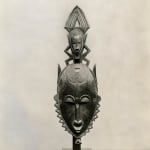[Barnes Foundation]
Photographs Showing the Museum's Collection of African Art, 1926
Silver prints (13)
From 8 1/2 x 7 inches to 11 1/2 x 7 3/4 inches
Each with Barnes Foundation stamp and manuscript notations verso.
Each with Barnes Foundation stamp and manuscript notations verso.
Further images
-
(View a larger image of thumbnail 1
)

-
(View a larger image of thumbnail 2
)

-
(View a larger image of thumbnail 3
)

-
(View a larger image of thumbnail 4
)

-
(View a larger image of thumbnail 5
)

-
(View a larger image of thumbnail 6
)

-
(View a larger image of thumbnail 7
)

-
(View a larger image of thumbnail 8
)

-
(View a larger image of thumbnail 9
)

-
(View a larger image of thumbnail 10
)

-
(View a larger image of thumbnail 11
)

-
(View a larger image of thumbnail 12
)

Rare suite of photographs documenting the African Art collection of the Barnes Foundation, used to illustrate the seminal 1926 publication “Primitive Negro Sculpture” by the pioneering French art dealer Paul...
Rare suite of photographs documenting the African Art collection of the Barnes Foundation, used to illustrate the seminal 1926 publication “Primitive Negro Sculpture” by the pioneering French art dealer Paul Guillaume and the American art philosopher and educator Thomas Munro. The book was the first publication from the Barnes Foundation, which had opened a year earlier.
Alfred Barnes began collecting African sculpture in 1922, in part because of its outsized influence on artists such as Picasso, Modigliani, and countless others, but largely because of his deep-felt appreciation for the work on its own terms. He considered African sculpture to be the purest expression of three-dimensional form.
The photographer of these images is unidentified, but their skilled ability to capture the artworks' complexities is in line with American photographers who engaged with similar subject matter, such as Charles Sheeler, Walker Evans, and Man Ray,
The book was originally published with attributions and approximate dates by Guillaume, many of which were off by hundreds of years. The manuscript captions differ slightly from the illustration titles in the book, which are as follows:
1. ( Frontispiece ) Ivory Coast mask; Dan, XIIIth century
8. Ivory Coast mask; Dan - Yaboubas, XIIth century
9. Gabun head; Pahouin
11. Gabun figure; Pahouin, Xth century
16. Sudan figure, XVth century; side view
21. Ivory Coast figure; Baule XIVth century; side view
27. Ivory Coast mask; Baule , XIVth century
28. Ivory Coast mask; Mossi, XIVth century
30. Ivory Coast mask; Dan - Yaboubas , XIIth century
31. Congo figure; Bushongo , XIVth century
33. Congo figure, supporting table ; XVIIth
36. Congo figure; Bushongo - Baluba , XIVth century
41. Guinea figure, XVth century
Alfred Barnes began collecting African sculpture in 1922, in part because of its outsized influence on artists such as Picasso, Modigliani, and countless others, but largely because of his deep-felt appreciation for the work on its own terms. He considered African sculpture to be the purest expression of three-dimensional form.
The photographer of these images is unidentified, but their skilled ability to capture the artworks' complexities is in line with American photographers who engaged with similar subject matter, such as Charles Sheeler, Walker Evans, and Man Ray,
The book was originally published with attributions and approximate dates by Guillaume, many of which were off by hundreds of years. The manuscript captions differ slightly from the illustration titles in the book, which are as follows:
1. ( Frontispiece ) Ivory Coast mask; Dan, XIIIth century
8. Ivory Coast mask; Dan - Yaboubas, XIIth century
9. Gabun head; Pahouin
11. Gabun figure; Pahouin, Xth century
16. Sudan figure, XVth century; side view
21. Ivory Coast figure; Baule XIVth century; side view
27. Ivory Coast mask; Baule , XIVth century
28. Ivory Coast mask; Mossi, XIVth century
30. Ivory Coast mask; Dan - Yaboubas , XIIth century
31. Congo figure; Bushongo , XIVth century
33. Congo figure, supporting table ; XVIIth
36. Congo figure; Bushongo - Baluba , XIVth century
41. Guinea figure, XVth century
![[Barnes Foundation], Photographs Showing the Museum's Collection of African Art, 1926](https://artlogic-res.cloudinary.com/w_1600,h_1600,c_limit,f_auto,fl_lossy,q_auto/artlogicstorage/dollc/images/view/7c146ebd367b62636f540f9aabd119a6j/daniel-oliver-barnes-foundation-photographs-showing-the-museum-s-collection-of-african-art-1926.jpg)
![[Barnes Foundation], Photographs Showing the Museum's Collection of African Art, 1926](https://artlogic-res.cloudinary.com/w_1600,h_1600,c_limit,f_auto,fl_lossy,q_auto/artlogicstorage/dollc/images/view/a103c8b06c02f57352b835bcfe067dfbj/daniel-oliver-barnes-foundation-photographs-showing-the-museum-s-collection-of-african-art-1926.jpg)
![[Barnes Foundation], Photographs Showing the Museum's Collection of African Art, 1926](https://artlogic-res.cloudinary.com/w_1600,h_1600,c_limit,f_auto,fl_lossy,q_auto/artlogicstorage/dollc/images/view/3d68fb54ae3c7e1aec2b0bff789ff3daj/daniel-oliver-barnes-foundation-photographs-showing-the-museum-s-collection-of-african-art-1926.jpg)
![[Barnes Foundation], Photographs Showing the Museum's Collection of African Art, 1926](https://artlogic-res.cloudinary.com/w_1600,h_1600,c_limit,f_auto,fl_lossy,q_auto/artlogicstorage/dollc/images/view/ff606668630c931ebcab9be389a5ac1dj/daniel-oliver-barnes-foundation-photographs-showing-the-museum-s-collection-of-african-art-1926.jpg)
![[Barnes Foundation], Photographs Showing the Museum's Collection of African Art, 1926](https://artlogic-res.cloudinary.com/w_1600,h_1600,c_limit,f_auto,fl_lossy,q_auto/artlogicstorage/dollc/images/view/7ec8e9c378e73fce09d293b7c0cbf784j/daniel-oliver-barnes-foundation-photographs-showing-the-museum-s-collection-of-african-art-1926.jpg)
![[Barnes Foundation], Photographs Showing the Museum's Collection of African Art, 1926](https://artlogic-res.cloudinary.com/w_1600,h_1600,c_limit,f_auto,fl_lossy,q_auto/artlogicstorage/dollc/images/view/b1e9091a86b05a24af7a3c3e953ef164j/daniel-oliver-barnes-foundation-photographs-showing-the-museum-s-collection-of-african-art-1926.jpg)
![[Barnes Foundation], Photographs Showing the Museum's Collection of African Art, 1926](https://artlogic-res.cloudinary.com/w_1600,h_1600,c_limit,f_auto,fl_lossy,q_auto/artlogicstorage/dollc/images/view/02b58d002f27699f495e004c7715c0dbj/daniel-oliver-barnes-foundation-photographs-showing-the-museum-s-collection-of-african-art-1926.jpg)
![[Barnes Foundation], Photographs Showing the Museum's Collection of African Art, 1926](https://artlogic-res.cloudinary.com/w_1600,h_1600,c_limit,f_auto,fl_lossy,q_auto/artlogicstorage/dollc/images/view/d695fb5255bde865999e442b33e1d2c4j/daniel-oliver-barnes-foundation-photographs-showing-the-museum-s-collection-of-african-art-1926.jpg)
![[Barnes Foundation], Photographs Showing the Museum's Collection of African Art, 1926](https://artlogic-res.cloudinary.com/w_1600,h_1600,c_limit,f_auto,fl_lossy,q_auto/artlogicstorage/dollc/images/view/7a77d720dba4aa35eca1d453e045ffcaj/daniel-oliver-barnes-foundation-photographs-showing-the-museum-s-collection-of-african-art-1926.jpg)
![[Barnes Foundation], Photographs Showing the Museum's Collection of African Art, 1926](https://artlogic-res.cloudinary.com/w_1600,h_1600,c_limit,f_auto,fl_lossy,q_auto/artlogicstorage/dollc/images/view/41dc5ab11d66bae59002c3736a2081e6j/daniel-oliver-barnes-foundation-photographs-showing-the-museum-s-collection-of-african-art-1926.jpg)
![[Barnes Foundation], Photographs Showing the Museum's Collection of African Art, 1926](https://artlogic-res.cloudinary.com/w_1600,h_1600,c_limit,f_auto,fl_lossy,q_auto/artlogicstorage/dollc/images/view/1670c78927bab9200383cbfac3ba0e7aj/daniel-oliver-barnes-foundation-photographs-showing-the-museum-s-collection-of-african-art-1926.jpg)
![[Barnes Foundation], Photographs Showing the Museum's Collection of African Art, 1926](https://artlogic-res.cloudinary.com/w_1600,h_1600,c_limit,f_auto,fl_lossy,q_auto/artlogicstorage/dollc/images/view/4a7bdfe6b88094d62e3ebb52c133ec63j/daniel-oliver-barnes-foundation-photographs-showing-the-museum-s-collection-of-african-art-1926.jpg)